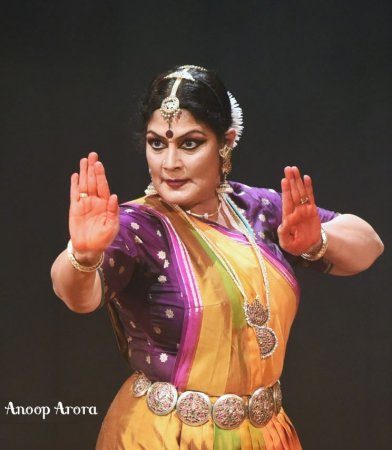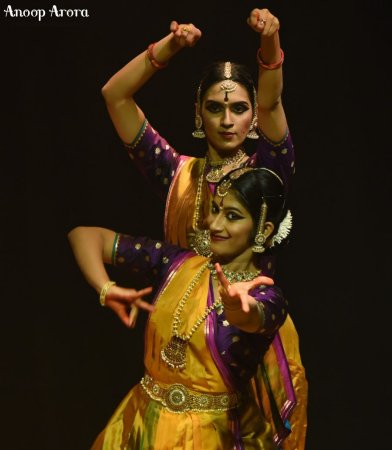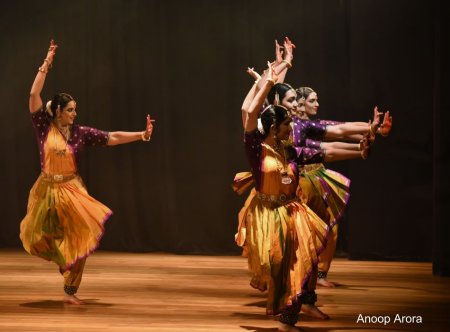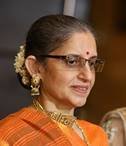
|   |

|   |
Geeta Chandran's Samagati is a choreographic triumph of art and bhakti - Shveta Arora e-mail: arorashveta1806@gmail.com Photos: Anoop Arora February 7, 2024 It was an experience. In fact, it was many experiences delivered altogether - many moments of elation, awe, joy and pure bliss. As a viewer of the performance of 'Samagati' by the Natya Vriksha Collective, I experienced a plethora of rasas in one transcendent evening. On 11 December 2023 at the Chinmaya Mission, Delhi, Geeta Chandran and her Natya Vriksha Dance Collective presented 'Samagati'. 'Samagati' literally means coming together, union or progressing together. There is already dynamism in the word. To this was added the philosophical layer of the chaturvidh purushartha in the Sanatana Dharma: artha, dharma, kama, moksha. Geeta Chandran has tried to bring these values to her choreographies in 'Samagati' and explore the connotations of the purusharthas in the contemporary context.  Geeta Chandran 
The first piece was on dharma. How one practises dharma and worship is very personal and the choice of one's idol is also individual. It was a tribute to Lord Shiva, the presiding deity of dance. He is the Nataraja and his tandava represents cosmic energy and dynamism, the very foundation of dance. Shiva is the god who presides over the panchabhoota or the five elements: ether, air, fire, earth and water. And as it is our dharma, we should work towards preserving these five elements, which form the basis of all creation. The composition used for this was by Puttunari Subramanian, the music was by O.S. Arun, and the choreography by Geeta Chandran. The dancers wore purple and gold-yellow sarees which had green and red borders. It was a nritta piece. The dancers took postures to depict the attributes of Shiva: Nandi as the steed, the booming damru, hands moving on both sides to shows the jatas or matted locks of Shiva, wave-like movements depicting the Ganga flowing down from them. One of the dancers took the posture of Shiva with her leg raised behind her. The chandra is like a crescent on his head, the damru goes dag-dag, the five elements are the building blocks of all creation and the life forms are his creation. Finally, Madhura Bhrushundi stood in the centre in a broad plie holding the damru. The piece had recorded music and the dancers were so well-rehearsed that at no point did they seem out of sync with the music or with each other. The second piece represented artha or material wealth which, according to the choreographer, is connected with hard work and diligence. The piece was a jatiswaram in raag Poorvi Kalyani, a composition of the Tanjore Quartet. It was in the spirit of Thirumudi, one of the physical symbols of infinity, that Geeta composed the jatiswaram. An abstract nritta piece, it explored the infinite possibilities of rhythm and how it resonates in movement. The adavus have been reinterpreted anew in time and space. The symbol of infinity represents the infinite ways in which humankind works towards artha. The piece was a riot of percussion, rhythm, jatis, bols and movement. The dancers moved in diagonal formations to form the looped symbol.  The next piece was 'Maye', depicting kama. Kama is desire, which is an illusion since it makes you run after something that is eluding you. 'Maye' shows that mankind is in the grip of unforeseen forces. Man is but a puppet in the hands of maya and Geeta has interpreted this aspect in her choreography. It is based on a composition by Muthuswami Dikshitar. The lighting for this piece was red, as if the dancers were bearing the wrath of maya. All are crying and wailing for help. Geeta stood in the centre and the dancers appeared to be holding her captive, blocking her way with their hands outstretched. She looks for help as she is being pushed and jostled. They try and capture something which is illusory. Geeta's choreographic prowess was on display - the front row dancers become puppets whose strings are being pulled by the dancers standing behind them. The moves were well-coordinated. The dancers depicted being caught in a net or maya jaal. And finally, maya comes to them as a venomous snake. The dancers kept moving in pairs, one as the puppet and the other as the puppeteer. It was a demonstration of awesome coordination and practice between the pairs of dancers, with the dancer depicting the puppet performing abrupt, jerky moves. In the last bit, the dancers plead to the Almighty to come to the aid of the human who dances to the tunes of the circumstances. The dancers depicted the musical instruments. Finally, Geeta in the centre showed the path to breaking the shackles of the senses and dispelling the darkness. The final piece was about moksha. Moksha is a state of sublimation of the self, attaining the highest gati of achieving the Almighty and ending the vicious cycle of birth and death. And to me, the use of rasa leela to show moksha was most appropriate. The gopis surrendered themselves totally to Krishna to attain the bliss of uniting with him. For the experience of moksha or that ultimate union, Geeta chose the maharaas of Vrindavan between Radha, Krishna and the gopis. Hita Harivansh was the composer of the poetry, and the music was in ragamalika. The raas is danced on the full moon night of Sharad Poornima on the banks of the Yamuna. The gopis are dressed in all their finery and various musical instruments are being played. Each gopi thinks that Krishna is dancing with her and finds her moksha.  The dancers added a green fan to their costume for the piece and Geeta wore a green patka, which added vibrancy to the costume. Krishna, after realizing that the gopis were filled with vanity at their looks and the fact that they had Krishna's love, disappears suddenly from among them. The virahini gopis call out to him and each one of them have a different reason to tell Krishna that he should come back soon. The sequence was choreographed very aesthetically to show the distraught gopis. They hear his flute and lo and behold, there he was. One makes chandan for him, another engages him in play holding his hands, a third embraces him and yet another kisses him. Geeta as Krishna goes to each gopi and whatever they had wished for comes true when they are embraced, tickled on the cheeks with the peacock feather and playfully caressed with the patka. And then begins the raas: khelat raas rasik van mandal, yuvatin ank diye bhuj kanthan. The sancharis were performed by Geeta standing right in the centre, spotlit by rays of light. The abhinaya shows the gopis leaving everything as it is when they hear the flute. They even abandon their children when they hear the magical flute: sharad vimal nabh chandra virajat. On the full moon night, the gopis dance with Krishna, each one holding his hand. The moon dances within its chandrika, the Yamuna dances, the lotuses dance. The gopis become creepers entwined around the Shyam tree. They are the chandan, vanamala, pitambar, all over him. Even Kamadev has lost himself in this raas of divine love. It was not only the abhinaya, which expressed all the shades of the raas, but the nritta, nattuvangam, the vocals and the percussion which created the Vrajmandal for the audience. The group moved together back and forth, sideways and in circles together or in cascading movements. The looking at the moon with a backward leg stretch, the playing of the instruments with forward and backward leg lifts, jatis with rhythmic claps, all were a choreographer's achievements. The ultimate stance of Krishna in the centre and the gopis all around him, looking, beholding, embracing him, was an enthralling experience for a Krishna bhakta like me. A union in unison - 'Samagati'. The dancers in the production, apart from Geeta Chandran were Radhika Kathal, Madhura Bhrushundi, Shruta Gopalan, Sowmya Lakshmi Narayanan, Anandita Narayanan and Yadavi Shakdher-Menon. Light design was by Gyan Dev, costume design by Sandhya Raman and make-up by Brij Mohan Gupta.  Shveta Arora is a dance-mad writer who chronicles classical dance events in Delhi (and also those online). In 2009, she started the blog Kala Upasana at delhiculturecomment.blogspot.com, where she began posting her own writing along with photographs clicked by Anoop Arora, her husband. She's been dancing all her life as a devotee, but resumed her formal training in Kathak in her 50s and has passed her fifth year Kathak exams. |